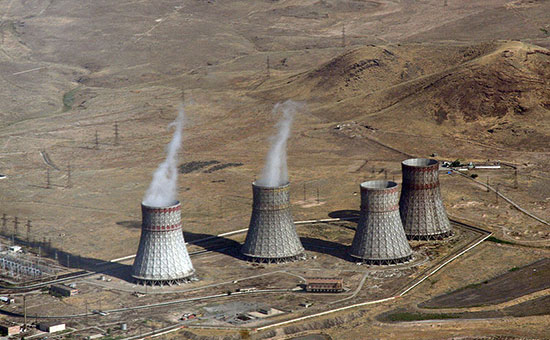
Armenia Presses Ahead with Nuclear Power Plant Construction
Publication: Eurasia Daily Monitor Volume: 6 Issue: 103
By:

Armenia is pressing ahead with its ambitious plans to build a new nuclear power station to replace the aging Soviet-era facility at Metsamor slated for decommissioning by 2017. The Armenian government has commissioned an Australian engineering company to manage the project. However, the key question of who will provide the funding needed for the plant’s construction remains unanswered.
The authorities in Yerevan formally agreed in 2007 to close the Metsamor plant after several years of pressure from the United States and the European Union, which considered it to be inherently unsafe. The E.U. in particular, had classified the VVER 440 Model V230 light water-cooled reactors as the "oldest and least reliable" category of all the 66 Soviet reactors built in Eastern Europe and the former Soviet Union.
Metsamor had two such reactors when it began operating at full capacity in 1980. They both were brought to a halt shortly after the 1988 catastrophic earthquake that devastated much of northwestern Armenia. Dismissing the Western concerns and those of local environmentalists, the country’s first post-communist government reactivated one of the reactors in 1995 to end a severe energy crisis caused by the war with Azerbaijan and broader turmoil within the region. The U.S. and the E.U. have since spent substantial sums on upgrading the facility’s equipment and financing other safety measures.
Successive Armenian governments have maintained that Metsamor, which generates over 40 percent of the country’s electricity, will be decommissioned only when they find an alternative source of inexpensive energy. For the administration of former President Robert Kocharian, a new nuclear plant meeting modern safety standards was considered as the most viable alternative. Kocharian’s successor, Serzh Sargsyan, strongly supports the idea, having declared its realization as a top economic priority after taking office in April 2008. Significantly, the U.S. also supports it in principle. The first $2 million feasibility study on the project conducted last year was also financed by the U.S. government.
In December 2008, Yerevan tendered for the right to design the new atomic reactor and oversee its construction. The Sydney-based company WorleyParsons, one of the world’s largest providers of engineering services to the energy sector, was declared as its winner on May 12 (Statement by the Armenian State Procurements Agency, May 12). WorleyParsons and the Armenian government are currently working out the precise details of the project management and will shortly sign a relevant agreement. In early April, the Armenian parliament passed a bill regulating the various aspects of the plant’s construction.
On May 18 the Armenian Energy Minister Armen Movsisian said, "The next step will be to design the future block, after which we will enlist and select potential investors." He further explained: "That will be followed by the design work and the construction process itself." According to Movsisian the construction will start "at the end of next year or at the beginning of 2011" and take at least five years (RFE/RL Armenia Report, May 18).
The estimated cost of the project, approximately $5 billion, is equivalent to 40 percent of Armenia’s GDP in 2008 and twice the volume of its 2009 state budget, meaning that foreign investment is the only realistic source of funding. Attracting such investment during the current global economic crisis will be an extremely difficult task. Thus far, only the Russian Federal Agency on Atomic Energy (Rosatom) and its state-owned Atomstroyexport company have publicly expressed interest in the large-scale project. The Armenian and Russian governments formed a joint task force in 2007 to examine the issue. The results of its work have still not been publicly disclosed.
With a projected capacity of 1,000-1,200 megawatts, the new nuclear plant will be more than twice as powerful as Metsamor’s functioning reactor, leaving Armenia with a potentially massive electricity surplus which energy officials hope to export to neighboring countries. On May 7 the Yerevan business daily Kapital quoted the chairman of the ArmRosGazprom national gas distribution company, Karen Karapetian, as saying that Georgia, Turkey and Iran will increasingly face electricity shortages in the coming years and that Armenia is in a position to alleviate the deficit. Karapetian said Armenian energy exports to these countries might eventually exceed 6 billion kilowatt hours annually, a figure equaling the total Armenian electricity output in 2008.
Armenia is already scheduled to supply Iran with large quantities of electricity to be generated using Iranian natural gas. It began importing that gas on May 14, around six months after the official inauguration of the second and final Armenian section of a gas pipeline connecting the two nations (Arminfo, May 14). Speaking to the Armenpress news agency on May 21, Movsisian reasserted that Armenia will soon start selling electricity to Turkey, despite the absence of diplomatic relations. He said the Turkish government is currently making the final technical preparations for the electricity supply, which will initially involve 1.5 billion kilowatt hours annually.
The Armenian energy minister has repeatedly stated in recent months that domestic and Turkish utility firms signed an agreement to that effect during President Abdullah Gul’s historic visit to Yerevan in September 2008. Turkish government officials have pointedly refused to offer any public confirmation of that deal. Nonetheless, the current uncertain prospects surrounding the normalization of Turkish-Armenian relations hardly bode well for any energy cooperation between Ankara and Yerevan.




